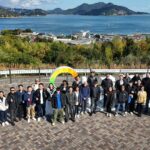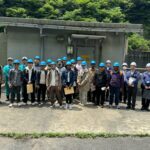1 Internship Title:
“Data Collection and Field Survey of Tsunami Sunda Strait Cases (Pandeglang area, Indonesia)”
2 Objectives:
In this field internship, the student will visit several places regarding coastal hazard prevention (tsunami, storm prevention, and flood control gates) in Osaka, Kobe, and Tokyo. The knowledge from these places (museums and control gates) hopefully can broaden student’s mind and information that can support his research.
In this trip, student had visited several institution and field survey regarding with past sunda strait tsunami in Jakarta (BASARNAS), Pandeglang (BPBD Kab. Pandeglang and Field Survey), and Bandung (PU Bandung and ITB). The main objective of this trip was to collect data related to damaged infrastructure, casualties information, and etc. in Pandeglang area.
3 Participant
Name : Ricard Diago Sambuaga (Graduate School for International Development and Cooperation (IDEC)), Hiroshima University
Name : Mochamad Riam Badriana Student (Graduate School for International Development and Cooperation (IDEC)), Hiroshima University
Name: Han Soo Lee, CEHSS lab, IDEC, Hiroshima University
4 Schedule Plan
October 7 ~ 12, 2019: Singapore –> Jakarta –> Pandeglang –> Jakarta –> Bandung –> Japan
5 Report
5.1 BASARNAS
BASARNAS (Indonesian: Badan Nasional Pencarian dan Pertolongan) or The National Search and Rescue Agency is a government agency of Indonesia. The central office of this government is in Kemayoran, Central Jakarta, Jakarta, Indonesia . BASARNAS primary task are to assist president in implementation of search and rescue activity in Indonesia, according to presidential decree No.99/2007. There are many functions of BASARNAS, such as: Formulation of national and general policies in search and rescue, implementing relation and cooperation in the field of in search and rescue, Implementation of search and rescue, Provide report, suggestion and consideration in the field of search and rescue, and etc.
In this trip, students were visited BASARNAS for data collection purposes. Data collection that needed from BASARNAS regarding with the victims and infrastructures damage detail information such as the locations where the victims were found, the gender and ages, local and regional regulation for evacuation and early warning systems. These data would be used as an input for modeling in agent-based model for evacuation process.
In this trip, we met Mr. Setiono at 10th floor, BASARNAS Building. We met Mr. Setiono at 09.00 AM (Indonesian time). In this meeting, we had some presentation regarding to our research. Hansoo Lee- sensei did a presentation regarding to Tsunami modeling and other research projects in Chess Laboratory. I did a presentation related to Agent-Based Modeling for evacuation simulation for Sunda Strait tsunami. Figure can be seen in Figure 5-1 and Figure 5-2 below.
Mr. Setiono also did a presentation and explanations related with evacuation of citizens in Pandeglang (Java Island) and Lampung (Sumatera Island). BASARNAS did a search and rescue for casualties caused by this event. Mr. Setiono also explained about work flow for search and rescue activities and how it cooperates with another government departments or institutions. In this meeting, we got many information and data regarding with detail casualty’s information in Lampung and Pandeglang area. This data contains many information such as: ages, gender, location (Lampung area) and casualties’ location (sub-district scale) in Pandeglang area.
Location: BASARNAS Central Office, Jl. Angkasa No.2-3, RW.10, South Gunung Sahari, Kemayoran, Central Jakarta City, Jakarta 10610, Indonesia TEL. +62 21 65701116 URL: http://basarnas.go.id/
5.2 BPBD Kab. Pandeglang
BPBD (Indonesian Badan Penanggulangan Bencana Daerah; Regional Disaster Management Authority) Kab. Pandeglang is a district/regional level (Pandeglang, Banten) of a National Agency for Disaster Countermeasure (officially National Disaster Management Authority). It is the Indonesian board for national disaster affairs. BNPB and BPBD have a same duties and functions, but the differences are a scope of work and scale of disaster risk. Functions for BNPB: formulation and establishment of disaster management policies and handling of refugees to act quickly and appropriately and effectively and efficiently; and Coordinating implementation of disaster management activities in a planned, integrated, and comprehensive. Duties for BNPB are provide guidance and direction on disaster management effort that includes disaster prevention, emergency response, rehabilitation, and reconstruction in a fair and equitable; assigning the standardization and implementation of disaster management needs based on laws and regulations; use and account for donations / support national and international; account for the use of funds received from the state humans; and etc.
In this trip, we went to BPBD Kab. Pandeglang for collecting data purposes. The data that needed in this trip has already stated in previous section (BASARNAS section). In BPBD Kab. Pandeglang, we met a secretary of BPBD Kab. Pandeglang and also Mr. Deni Musadad as a member of PUSDALOPS of BPBD Pandeglang. In the afternoon, we met and discuss with a secretary about a story of tsunami event in their area. He told us that when tsunami happens, there were no preparation to evacuate peoples around coastal area. He said that it was so difficult to rescue and search the people in a night time and also because of road condition in coastal area was not good. After discussing with Mr. secretary, we continue to do a field survey and comeback to BPBD in the night time. It is because, we can discuss with Mr. Deni Musadad at that time and we can get some information or data related to Tsunami Sunda Strait. The data that provided by BPBD are related to infrastructure damage in many sectors (houses, transportations, etc.), economic losses, hazard map, evacuation route, locations of temporary shelters, and etc. Figure 5-3, Figure 5-4, and Figure5-5 are a plotting map for damaged houses information, evacuee information, and casualties information in Pandeglang.
According to pictures above, bold lines is a boundary of my research interest or focus of my research in Pandeglang area. Figure 5-5 is described which location has the highest number of casualties (peoples passed away) caused by tsunami. Panimbang sub-district has the highest casualties (129 people passed away). In Figure 5-6 are a documentation of our meeting with secretary of BPBD and Mr. Deni Musadad (PUSDALOPS BPBD).
Location: BPBD Kab. Pandeglang Office, Jl.Raya Cikoneng KM 5 Pandeglang, Banten, 42253 Indonesia. TEL. +62 (253) 204479 URL: https://bpbd.bantenprov.go.id/id/read/kab-pandeglang.html
5.3 Field Survey
On October 09th, 2019 after first meeting with a secretary of BPBD Kab. Pandeglang, we went to field survey around the coastline. Location that we visit were Tanjung Lesung Beach Club, Cipenyu Beach, and Tsunami evacuation shelter in Labuan. Tanjung Lesung Beach Club was one of hotel that have many casualties in that area. This hotel had a music concert when tsunami happen. This concert affected by tsunami was very famous in many news and many platform of social media, because some artists and also many citizens were passed away. It is located in Tanjung Lesung, Panimbang, Pandeglang. There were many evidences of damaged trees, flipped big boulders, damaged building can be seen in that area. We got around in that hotel accompanied with Mr. Kunto Wijoyo as a Director of Tanjung Lesung Beach Club. Figure 5-7 and Figure 5-8 are described of evidence of damaged trees, flipped boulders, and damaged houses. Big boulders size in Figure 5-7 (a) is 2-3m height approximately. Based on Figure 5-8 (a) below, we can predict that this trees were damaged by tsunami around 3.5-4 meters.
Near hotel, we saw a high ground that used as evacuation shelter. The coordinate of this shelter is -6.4982618, 105.6675630. Peoples can reach this high ground around 35 minutes by walking or 7 minutes by car. Figure 5-9 and Figure 5-10 are described a high ground that can be used as evacuation shelter in case of tsunami. This high ground name is Bukit Tanjung Lesung 1.
After we visited Tanjung Lesung Beach Club and evacuation shelter, we went to Cipenyu beach. We want to Cipenyu beach to make sure some hypotheses that stated in Tsunami and Disaster Mitigation Research Center (TDMRC), Syiah Kuala University, Indonesia. They said that, there were some boulders that drifted by tsunami in Cipenyu Beach. After we saw some boulders in this location and also ask villagers regarding to this issue and past tsunami event. We provide other hypotheses that these boulders were not drifted or lifted from below the sea and delivered to land surface, but these boulders only flipped by the tsunami. This hypothesis is obtained from the color of boulders and statement from villagers. Figure 5-11 and Figure 5-12 are described about cipenyu beach condition after tsunami (evidences).
We continue to visit a tsunami shelter in Labuan, Pandeglang. It took 48-60 minutes by car to went there from Cipenyu Beach to Tsunami shelter, Labuan. The location of shelter is in the middle of traditional market area. The shelter was not in a good condition, because there were many vandalism inside this building, it was dirty, many refugee tents was not well maintained, and unuseful toilet. This shelter has 3 (three) floors and 2,456 sq. meter area. This building has a total capacity around 2000 peoples. Figure 5-13, Figure 5-14, and Figure 5-15 described about the actual condition of tsunami shelter that used in previous event. Some villager around shelter said, “when tsunami happened on last event, there were many residents are evacuated into this shelter. Most of them were an old people, women, and kids, but for a younger people and men were evacuated to another places. They were evacuated to higher ground around that area.”
5.4 Research Center for Water Resources, Ministry of Public Works and Housing
On 11th October, we visited Research Center for Water Resources under Ministry of Public Works and Housing in Bandung. Ministry of Public Works and Housing offices located in several location in Indonesia, depends on their focus and main work. The main office located in Jakarta, however in Bandung, the office focus in water resources while the experimental station for coastal is located in Bali. Fortunately, our advisor made a contact with them to meet in Bandung. We met several researcher, such as Dr. Eng. Adi Prasetyo, Huda Bachtiar, B.Sc M.Sc, Leo E Sembiring, PhD (head of experimental station for coastal engineering), Dr. Arno Adi Kuntoro, ST., MT. (Water Resources lecturer in ITB), and Eduardo, B.Sc. As the representative our lab, Han Soo Lee and Riam presented ongoing research in CHESS Lab, particularly Diago presented main objective of the field survey regarding the tsunami evacuation. Eduardo explain the research regarding tsunami Krakatau (occurred in 1883), however the research is more focus in Jakarta bay region instead in Banten or Pandeglang region. The discussion result became our feedback for our further research. Figure 5-16 is a documentation of our meeting with members of PU Bandung.
Location: Water Resouces (Pusair) Office, Jl. Ir. H. Juanda No. 193 Bandung, Jawa Barat 40135 TEL. (022) 2501554, 2500507, 2504053 Fax (022) 2500163
email: pusat@pusair-pu.go.id
URL: http://www.pusair-pu.go.id/
5.5 Bandung Institute of Technology (ITB)
After we visited Research Center for Water Resources and had lunch break, we visited Bandung Institute of Technology. We went to Oceanography Department under Faculty of Earth Science and Technology. Accompanied with Dr. Arno Adi Kuntoro, we met Dr. Eng. Totok Suprijo, one of lecturer in oceanography department. He focuses on oceanography model, renewables energy, ocean and coastal morphology, and coastal management. We discussed several aspects and was not limited to our main objective. Hopefully, our lab and his department can collaborate more after his health recovered completely. Dr. Arno Adi Kuntoro took us to water experimental laboratory in Faculty of Civil and Environmental Engineering. We saw several small scale of coastal and valley region. This miniature will be helpful for study and investigate actual condition in civil construction, such as for dam, jetty, bridge, and flood scenario. At the end of the day, he took us to his office in one of new building in ITB. Figure 5-17 is a documentation of our visit to Dr. Arno Kuntoro Laboratory.
Location: Labtek XI, Institut Teknologi Bandung Jl. Ganesha 10, Bandung, Jawa Barat 40132 TEL. (022) 2500494, (022) 2505253
Fax (022) 2534139
email: pusat@pusair-pu.go.id
URL: https://www.oceanography.fitb.itb.ac.id/
6 Conclusion
Student had visited and discuss with many institutions and done a field survey. The aim of this trip is to collect many information and data related to past tsunami sunda trait event on December 2018. Data need to be collected in this trip are regarding with the victims and infrastructures damage detail information such as the locations where the victims were found, the gender and ages, local and regional regulation for evacuation and early warning systems. This trip is also help student to understand and know about real condition of affected area caused by tsunami by doing a field survey. Student need to process this data as an input to his tsunami evacuation model by using agent-based modeling.





